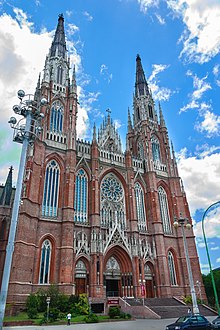As planned, we were met at the Buenos Aires dock by a driver who spoke only Spanish and a tour guide who was bilingual. The tour consisted of myself and my travel mate, a former co-worker and good friend. Our first surprise was that the car was a new, air conditioned, sedan that was very comfortable. La Plata was a 45 minute drive from our location in Buenos Aires. I showed the previous blog postings (I had printed them prior to the trip) to the guide who used the information as the basis for the tour.
La Plata is the capital of Buenos Aires province and it’s easy to get around since its streets are logically numbered, in what was one of the first planned cities in Argentina.
As expected, many of the locations mentioned in the blogs, dating back to the 1920s, had been replaced by other structures over the ninety some odd years since my grandparents, father and aunt were in the country. The guide did, however, take us to the streets where the buildings would have been and went out of their way to talk with current hotel managers who had some idea as to the history of the area.
The most anticipated part of the trip, and the one with the most obvious 1920s photographs was at the Plaza Moreno. It is an expansive and open area with broad views of the sky, city skyline and the towering neo-gothic cathedral, copied after one in Germany. Several religious statues are located around the plaza. While the gift shop was not open when we were there, I did notice that there was a large coffee-table book, in either Spanish or English, that was available. I was lucky enough to find the only available on-line copy just prior to my return.
The Cathedral of La Plata: The Largest Neo-Gothic Church of the Twentieth Century [Hardcover] Manrique Zago (Editor), Graciela Smith (Translator)
This cathedral is beautiful, both inside and out and I recommend a trip to La Plata just to see it and enjoy the beauty of the plaza. I've copied most of a wikipedia article below for your information. As noted in the article, the cathedral was started in 1884 and designated a cathedral in 1932, however, it really wasn't completed until 2000. The pictures of the cathedral in my grandfathers photos showed one spire. The finished cathedral has two.The tour guide, and the driver, went out of their way to try to match the blog entries. The driver especially spent some time tracking down the Armour and Company Meat Packing location, which we knew had been torn down some time ago. What he found, however, was another refrigeration company warehouse - spread over several blocks - in a downtrodden part of town. He advised that we might have to "make a run for it" if we found the area a bit too challenging. As it turns out the plant was still being used in the outskirts of town in a rundown residential area. The trip to that site alone as awe inspiring (maybe only for me).
In the early discussion with By-T travel, I was directed to an on-line article concerning cold storage units in La Plata (http://www.berisso-web.com.ar/frigor.html). The site is in spanish but can be translated to English. I mentions in that article that the Armour S. A. plant was closed in 1983 and demolished in 1986.
We were also treated to the exterior (it was closed) of the Natural History Museum and several other local attractions. It was a truly interesting day.
As we returned to Buenos Aires on our way to the touristy Florida Street, we went by the Buenos Aries Cathedral which from the outside looks like some sort of government building, not at all impressive. However, the inside is as beautiful as the cathedral was. Without this specialized tour we wouldn't have known what the inside of the cathedral looked like as most off-ship excursions don't give you enough time to wander into the cathedral.
La Plata lived up to what I had hoped when I first saw the old pictures. While many of the original buildings I had hoped to find were no longer available, the simple act of being in the town and standing in the general area of my ancestors made the trip a bargain.
Below is the promised article from Wikipedia, the free encyclopedia: http://en.wikipedia.org/wiki/Cathedral_of_La_Plata
Cathedral of La Plata
View of the lateral buttressing
Inspired by the European cathedrals of Amiens and Cologne, its plans were drawn by architect Ernesto Meyer under the direction of city planner Pedro Benoit. The cornerstone was laid in 1884, and it was consecrated as the Parroquia Nuestra Señora de los Dolores in 1902. The parish church, which continued undergoing works, was designated a cathedral in 1932.
Restoration and completion
In the 1930s, fearing that the foundation had been underestimated, workers halted construction. The spires were left unfinished and the exterior brick work was left undressed. In the mid 1990s, an ambitious plan of restoration and completion was carried out. The 1990s plan included the following:
- Strengthening the foundation.
- Reversing the damage in the bricks and joints.
- Completing two spires, six turrets, 200 pinnacles and 800 needles.
- Installing a 25-bell carillon.
With its towers rising 367 feet, it is among the four tallest churches in the Americas.







No comments:
Post a Comment